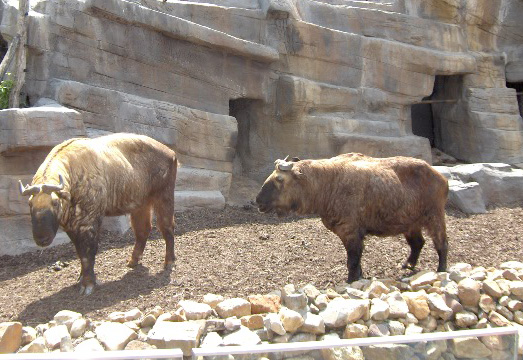- Takin
Taxobox
name = Takin
status = VU
trend = unknown
status_system = iucn2.3

image_width = 250px
regnum =Animal ia
phylum = Chordata
classis =Mammal ia
ordo =Artiodactyla
familia =Bovidae
subfamilia =Caprinae
genus = "Budorcas"
species = "B. taxicolor"
binomial = "Budorcas taxicolor"
binomial_authority = Hodgson,1850
subdivision_ranks =Subspecies
subdivision = "B. t. bedfordi
B. t. taxicolor
B. t. tibetana
B. t. whitei"The Takin ("Budorcas taxicolor") is a goat-antelope found in the Eastern
Himalayas . There are four subspecies: "B. taxicolor taxicolor", theMishmi Takin ; "B. taxicolor bedfordi", the Shensi orGolden Takin ; "B. taxicolor tibetana", the Tibetan orSichuan Takin ; and "B. taxicolor whitei", theBhutan Takin . Mitochondrial research [ [http://www.uaf.edu/lars/document_links/doclink20.html Pamela Groves and R.G. White, "The Takin And Muskox: Relationship musk not be takin for granted", Institute of Arctic Biology, University of Alaska Fairbanks ] ] shows that takin are related to sheep, its similarity to themuskox being an example ofconvergent evolution . The takin is thenational animal ofBhutan .Takin stand 110 to 120 centimetres (3 to 4 feet) at the shoulder and weigh up to 550 kg. [WWF: [http://www.panda.org/about_wwf/where_we_work/asia_pacific/where/china/wwf_china_conservation/qinling/takin/index.cfm Takin] ] They have been likened to a "bee-stung
moose ", because of the swollen appearance of the face. They are covered in a thick golden wool which turns black on the under-belly. Both sexes have small horns which run parallel to the skull and then turn upwards in a short point, these are around 30 centimetres long.Takin are found in
bamboo forests at altitudes of 2,000 to 4,500 metres - where they eatgrass ,bud s andleaves . Takin are diurnal, active in the day, resting in the heat on particularly sunny days. Takin gather in smallherd s inwinter and herds of up to a hundred individuals in thesummer , old males are solitary.Some theorise that the Takin may be the source of the
Golden Fleece inGreek mythology .The reason for Bhutan selecting the Takin as the national animal is based on both its uniqueness and its strong association with the country's religious history and mythology. According to legend, when the great saint Lama
Drukpa Kunley (called "the divine madman") visited Bhutan in the 15th century, a large congregation of devotees gathered around the country to witness his magical powers. The people urged the lama to perform a miracle. However, the saint, in his usual unorthodox and outrageous way, demanded that he first be served a whole cow and a goat for lunch. He devoured these with relish and left only bones. After letting out a large and satisfied burp, he took the goat's head and stuck it onto the bones of the cow. And then with a snap of his fingers, he commanded the strange beast to rise up and graze on the mountainside. To the astonishment of the people the animal arose and ran up to the meadows to graze. This animal came to be known as the "dong gyem tsey" (takin) and to this day, these animals can be seen grazing on the mountainsides of Bhutan.Photos
[http://www.arkive.org/media/4946AA70-CB80-45DD-A5E3-DD9BF00CD209/Presentation.Large/large-Bhutan-takin-female-on-hill-side.jpg] [http://www.mastfamilyfarm.com/wikipedia/takin1.jpg] [http://www.mastfamilyfarm.com/wikipedia/takin2.jpg] [http://www.mastfamilyfarm.com/wikipedia/takin3.jpg] [http://www.mastfamilyfarm.com/wikipedia/takin4.jpg]
References
* Listed as Vulnerable (VU A2cd v2.3)
* Lonely Planet Bhutan, Tashi Wangchuk.External links
*ARKive - [http://www.arkive.org/species/GES/mammals/Budorcas_taxicolor/ images and movies of the takin "(Budorcas taxicolor)"]
* [http://bhutan2008.blogspot.com/2007/04/takin-bhutan-national-animal.html Pictures of takin in Bhutan Zoo]
Wikimedia Foundation. 2010.
